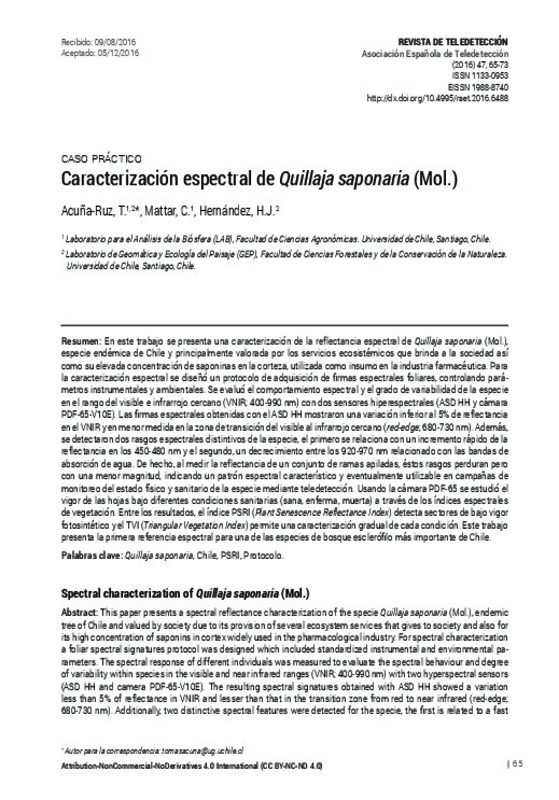JavaScript is disabled for your browser. Some features of this site may not work without it.
Buscar en RiuNet
Listar
Mi cuenta
Estadísticas
Ayuda RiuNet
Admin. UPV
Spectral characterization of Quillaja saponaria (Mol.)
Mostrar el registro sencillo del ítem
Ficheros en el ítem
| dc.contributor.author | Acuña, T.
|
es_ES |
| dc.contributor.author | Mattar, C.
|
es_ES |
| dc.contributor.author | Hernández, H. J.
|
es_ES |
| dc.date.accessioned | 2017-05-02T10:17:30Z | |
| dc.date.available | 2017-05-02T10:17:30Z | |
| dc.date.issued | 2016-12-27 | |
| dc.identifier.issn | 1133-0953 | |
| dc.identifier.uri | http://hdl.handle.net/10251/80307 | |
| dc.description | Revista oficial de la Asociación Española de Teledetección | |
| dc.description.abstract | [EN] This paper presents a spectral reflectance characterization of the specie Quillaja saponaria (Mol.), endemic tree of Chile and valued by society due to its provision of several ecosystem services that gives to society and also for its high concentration of saponins in cortex widely used in the pharmacological industry. For spectral characterization a foliar spectral signatures protocol was designed which included standardized instrumental and environmental parameters. The spectral response of different individuals was measured to evaluate the spectral behaviour and degree of variability within species in the visible and near infrared ranges (VNIR; 400-990 nm) with two hyperspectral sensors (ASD HH and camera PDF-65-V10E). The resulting spectral signatures obtained with ASD HH showed a variation less than 5% of reflectance in VNIR and lesser than that in the transition zone from red to near infrared (red-edge; 680-730 nm). Additionally, two distinctive spectral features were detected for the specie, the first is related to a fast increase of reflectance in bands 450-480 nm and the second, to a marked decrease in the 920-970 nm range associated with water absorption features. At branch level, these distinctive features are maintained but with a smaller magnitude of reflectance, which could indicate that they are useful characteristic spectral patterns that can eventually be used for monitoring the physical health state of the specie using remote sensing. On the other hand, we used a PDF-65 camera for study the plant vigour from different health states (healthy, ill, died) with spectral vegetation index. The Plant Senescence Reflectance Index detected stress on leaves, and Triangular Vegetation Index allows for a gradually characterization of every state. This work provides the first spectral reference for one of the most important sclerophyll species of Chile. | es_ES |
| dc.description.abstract | [ES] En este trabajo se presenta una caracterización de la reflectancia espectral de Quillaja saponaria (Mol.), especie endémica de Chile y principalmente valorada por los servicios ecosistémicos que brinda a la sociedad así como su elevada concentración de saponinas en la corteza, utilizada como insumo en la industria farmacéutica. Para la caracterización espectral se diseñó un protocolo de adquisición de firmas espectrales foliares, controlando pará-metros instrumentales y ambientales. Se evaluó el comportamiento espectral y el grado de variabilidad de la especie en el rango del visible e infrarrojo cercano (VNIR; 400-990 nm) con dos sensores hiperespectrales (ASD HH y cámara PDF-65-V10E). Las firmas espectrales obtenidas con el ASD HH mostraron una variación inferior al 5% de reflectancia en el VNIR y en menor medida en la zona de transición del visible al infrarrojo cercano (red-edge; 680-730 nm). Además, se detectaron dos rasgos espectrales distintivos de la especie, el primero se relaciona con un incremento rápido de la reflectancia en los 450-480 nm y el segundo, un decrecimiento entre los 920-970 nm relacionado con las bandas de absorción de agua. De hecho, al medir la reflectancia de un conjunto de ramas apiladas, éstos rasgos perduran pero con una menor magnitud, indicando un patrón espectral característico y eventualmente utilizable en campañas de monitoreo del estado físico y sanitario de la especie mediante teledetección. Usando la cámara PDF-65 se estudió el vigor de las hojas bajo diferentes condiciones sanitarias (sana, enferma, muerta) a través de los índices espectrales de vegetación. Entre los resultados, el índice PSRI (Plant Senescence Reflectance Index) detecta sectores de bajo vigor fotosintético y el TVI (Triangular Vegetation Index) permite una caracterización gradual de cada condición. Este trabajo presenta la primera referencia espectral para una de las especies de bosque esclerófilo más importante de Chile. | es_ES |
| dc.description.sponsorship | Este trabajo fue financiado por el proyecto Fondecyt 1140319 “Vegetation Knowledge-based Indicators for Urban Sustainable Planning” de CONICYT Chile. Los autores también agradecen a AGSEN y a SPECIM por contribuir con la imagen obtenida con la cámara hiperespectral PDF-65-V10E. | |
| dc.language | Español | es_ES |
| dc.publisher | Universitat Politècnica de València | |
| dc.relation.ispartof | Revista de Teledetección | |
| dc.rights | Reconocimiento - No comercial - Sin obra derivada (by-nc-nd) | es_ES |
| dc.subject | Quillaja saponaria | es_ES |
| dc.subject | Chile | es_ES |
| dc.subject | PSRI | es_ES |
| dc.subject | Protocolo | es_ES |
| dc.subject | Plant Senescence Reflectance Index | es_ES |
| dc.subject | Protocol | es_ES |
| dc.title | Spectral characterization of Quillaja saponaria (Mol.) | es_ES |
| dc.title.alternative | Caracterización espectral de Quillaja saponaria (Mol.) | es_ES |
| dc.type | Artículo | es_ES |
| dc.date.updated | 2017-05-02T07:38:12Z | |
| dc.identifier.doi | 10.4995/raet.2016.6488 | |
| dc.relation.projectID | info:eu-repo/grantAgreement/CONICYT//1140319/ | es_ES |
| dc.rights.accessRights | Abierto | es_ES |
| dc.description.bibliographicCitation | Acuña, T.; Mattar, C.; Hernández, HJ. (2016). Spectral characterization of Quillaja saponaria (Mol.). Revista de Teledetección. (47):65-73. https://doi.org/10.4995/raet.2016.6488 | es_ES |
| dc.description.accrualMethod | SWORD | es_ES |
| dc.relation.publisherversion | https://doi.org/10.4995/raet.2016.6488 | es_ES |
| dc.description.upvformatpinicio | 65 | es_ES |
| dc.description.upvformatpfin | 73 | es_ES |
| dc.type.version | info:eu-repo/semantics/publishedVersion | es_ES |
| dc.description.issue | 47 | |
| dc.identifier.eissn | 1988-8740 | |
| dc.contributor.funder | Comisión Nacional de Investigación Científica y Tecnológica, Chile |








